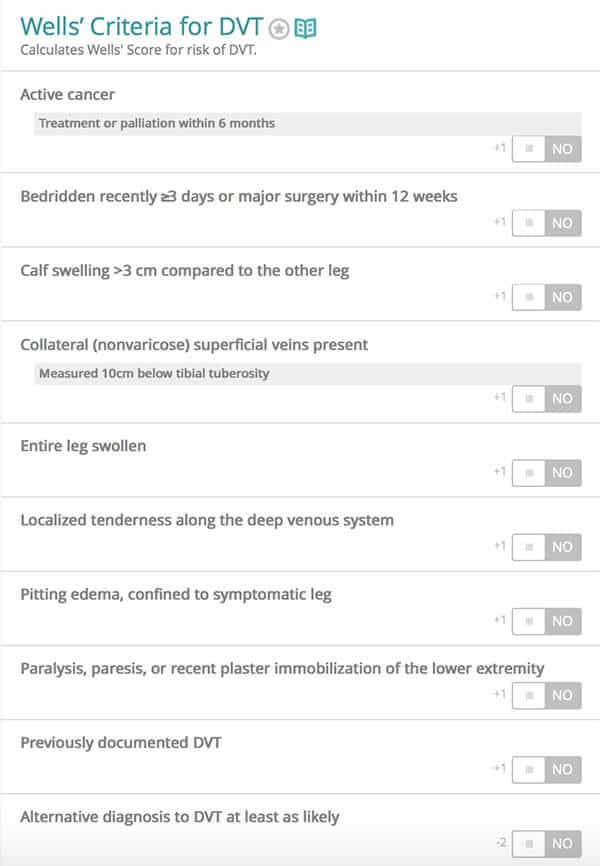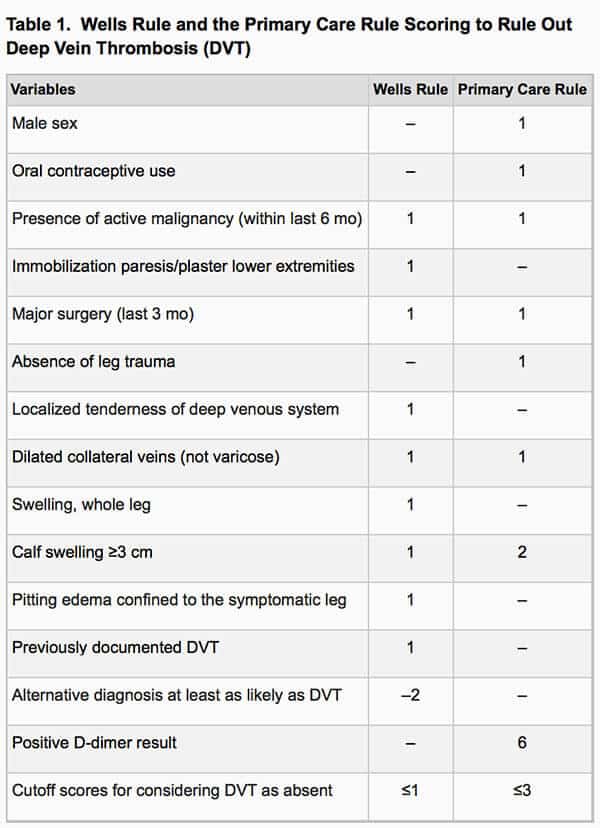Deep Venous Thrombosis(DVT) occurs in approximately 1-2 per 1000 of the population. Our great concern is not the DVT as such, but the potential for other sequelae, especially a pulmonary embolism. What I see and what I’m also guilty of, on several occasions is that these patients are simply sent to ultrasound and we don’t apply the well known Well’s Score(JAMA, 2006;295(2):199-207).
I was asked recently, “Do you use D-dimer to rule out your DVT’s?” I searched my brain and remember saying, ‘If they are a low pre-test probability I may just send them off”, but I knew that I had not calculated a Well’s Score in a long time……..so time to review.
 Well’s paper showed that using his diagnostic algorithm and a D-dimer, a DVT can be ruled out.
Well’s paper showed that using his diagnostic algorithm and a D-dimer, a DVT can be ruled out.
This image is taken from the MD Calc website calculator, which allows you to quickly calculate the score. You’ve probably got it on your smartphone.
It basically says that if the score is <2, then a DVT is unlikely and a D-dimer can be performed to rule it out. I would still get a high sensitivity quantitative D-dimer.
If the score is >2 then a DVT is more likely and an ultrasound needs to be done.
So in this table, if a patient presents with calf pain as their only complaint, i.e. no swelling, no other past history, then they would have a Well’s score of 1 and a D-dimer can rule them out.
The area that causes the greatest concern is the last item on the list; ‘Alternative diagnosis to DVT at least as likely’. This is your interpretation, your gestalt. It is your experience and gut feeling about the potential of another cause, based on the history and examination. For example, your thinking would be changed if someone came in with simple calf pain, but you found out that there had been direct muscle trauma. It appears that specialists do this better.
 For this reason, a new rule, the primary care rule(Ann Fam Med. 2011;9(1)131-36) has been developed to work around the need to have an opinion about alternative diagnosis and allow GP’s with point of care D-dimer testing(not sure how many of you out there have this) to sort in their rooms. This rule incorporates a qualitative D-dimer. What is different from the Well Score is that here the D-dimer must be done as part of the algorithm, whereas in the Well’s Score , it is only done if the score is <2. With this new rule, if the score is <4 then there is no DVT. Here there is no need for gestalt.
For this reason, a new rule, the primary care rule(Ann Fam Med. 2011;9(1)131-36) has been developed to work around the need to have an opinion about alternative diagnosis and allow GP’s with point of care D-dimer testing(not sure how many of you out there have this) to sort in their rooms. This rule incorporates a qualitative D-dimer. What is different from the Well Score is that here the D-dimer must be done as part of the algorithm, whereas in the Well’s Score , it is only done if the score is <2. With this new rule, if the score is <4 then there is no DVT. Here there is no need for gestalt.
The study used some 1000 patients and followed them up with questionnaires or via their GP’s and the miss rate of DVT, was about the same(maybe a little lower) than with Well’s Score.
I’m not sure about you, but I don’t need yet another score to remember. I’m going back to Wells and getting my gestalt going again.










